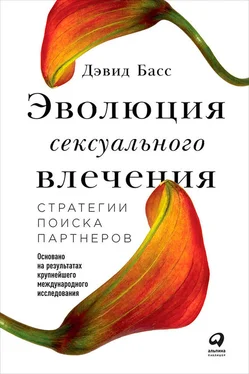Short, R. V. (1979). Sexual selection and its component parts, somatic and genital selection, as illustrated by man and great apes. Advances in the Study of Behavior, 9, 131–158.
Shostak, M. (1981). Nisa: The life and words of a! Kung woman. Cambridge, MA: Harvard University Press.
Sigusch, V., amp; Schmidt, G. (1971). Lower-class sexuality: Some emotional and social aspects in West German males and females. Archives of Sexual Behavior, 1, 29–44.
Singh, D. (1993a). Adaptive significance of waist-to-hip ratio and female physical attractiveness. Journal of Personality and Social Psychology, 65, 293–307.
–. (1993b). Body shape and female attractiveness: Critical role of waist-to-hip ratio. Human Nature, 4, 297–321.
–. (1994). Is thin really beautiful and good? Relationship between waist-to-hip ratio and female attractiveness. Personality and Individual Differences, 16, 123–132.
Singh, D., Vidaurri, M., Zambarano, R. J., amp; Dabbs, J. M. (1999). Lesbian erotic role identification: Behavioral, morphological, and hormonal correlates. Journal of Personality and Social Psychology, 76(6), 1035–1049.
Small, M. (1992). The evolution of female sexuality and mate selection in humans. Human Nature, 3, 133–156.
Smith, R. L. (1984). Human sperm competition. In R. L. Smith (Ed.), Sperm competition and the evolution of mating systems, 601–659. New York: Academic Press.
Smuts, B. B. (1985). Sex and friendship in baboons. New York: Aldine de Gruyter.
–. (1987). Sexual competition and mate choice. In B. B. Smuts, D. L. Cheney, R. M. Seyfarth, R. W. Wrangham, amp; T. T. Struhsaker (Eds.), Primate societies, 385–399. Chicago: University of Chicago Press.
–. (1992). Male aggression against women: An evolutionary perspective. Human Nature, 3, 1-44.
–. (1995). The origins of patriarchy: An evolutionary perspective. In A. Zagarell (Ed.), Origins of gender inequality. Kalamazoo, MI: New Issues Press.
Smuts, B. B., amp; Smuts, R. W. (1993). Male aggression against female primates: Evidence and theoretical implications. In P. J. B. Slater, J. S. Rosenblatt, M. Milinski, amp; C. T. Snowden (Eds.), Advances in the study of behavior. New York: Academic Press.
Souza, A. L., Conroy-Beam, D., amp; Buss, D. M. (2016). Mate preferences in Brazil: Evolved desires and cultural evolution over three decades. Personality and Individual Differences, 95, 45–49.
Spanier, G. B., amp; Margolis, R. L. (1983). Marital separation and extramarital sexual behavior. Journal of Sex Research, 19, 23–48.
Sprecher, S., Aron, A., Hatfield, E., Cortese, A., Potapova, E., amp; Levitskaya, A. (1992). Love: American style, Russian style, and Japanese style. Paper presented at the Sixth International Conference on Personal Relationships, Orono, Maine.
Stern, B. (1933). The scented garden: Anthropology of the sex life in the levant. New York: American Ethnological Press.
Sternberg, R. J. (1988). The triangle of love. New York: Basic Books.
Strassman, B. I. (1981). Sexual selection, parental care, and concealed ovulation in humans. Ethology and Sociobiology, 2, 31–40.
Stroebe, W. (1977). Self-esteem and interpersonal attraction. In S. W. Duck (Ed.), Theory and practice in interpersonal attraction, 79-104. London: Academic Press.
Studd, M. V., amp; Gattiker, U. E. (1991). The evolutionary psychology of sexual harassment in organizations. Ethology and Sociobiology, 12, 249–290.
–. (in preparation). Evolutionary psychology of sexual harassment: Effect of initiator profile and social context on response of recipients of sexual advances in the workplace. Faculty of Management, University of Lethbridge, Alberta.
Surbey, M. K., amp; Conohan, C. D. (2000). Willingness to engage in casual sex. Human Nature, 11(4), 367–386.
Symons, D. (1979). The evolution of human sexuality. New York: Oxford University Press.
–. (1987). If we're all Darwinians, what's the fuss about? In C. B. Crawford, M. F. Smith, and D. L. Krebs (Eds.), Sociobiology and psychology: Ideas, issues, and applications, 121–146. Hillsdale, NJ: Erlbaum.
–. (1989). The psychology of human mate preferences. Behavioral and Brain Sciences, 12, 34–35.
–. (1992). What do men want. Behavioral and Brain Sciences, 15(1), 113–114.
Takahashi, H., Matsuura, M., Yahata, N., Koeda, M., Suhara, T., amp; Okubo, Y. (2006). Men and women show distinct brain activations during imagery of sexual and emotional infidelity. Neuro-Image, 32(3), 1299–1307.
Tanner, R. E. S. (1970). Homicide in Uganda, 1964: Crime in East Africa. Uppsala, Sweden: Scandinavian Institute of African Studies.
Taylor, P. A., amp; Glenn, N. D. (1976). The utility of education and attractiveness for females' status attainment through marriage. American Sociological Review, 41, 484–498.
Teisman, M. W., amp; Mosher, D. L. (1978). Jealous conflict in dating couples. Psychological Reports, 42, 1211–1216.
Terman, L. M. (1938). Psychological factors in marital happiness. New York: McGraw-Hill.
Terpstra, D. E., amp; Cook, S. E. (1985). Complainant characteristics and reported behaviors and consequences associated with formal sexual harassment charges. Personnel Psychology, 38, 559–574.
Thakerar, J. N., amp; Iwawaki, S. (1979). Cross-cultural comparisons of interpersonal attraction of females toward males. Journal of Social Psychology, 108, 121–122.
Thibeau, J. W., amp; Kelly, H. H. (1986). The social psychology of groups. 2nd ed. New Brunswick, NJ: Transaction Books.
Thiessen, D., Young, R. K., amp; Burroughs, R. (1993). Lonely hearts advertisements reflect sexually dimorphic mating strategies. Ethology and Sociobiology, 14, 209–229.
Thompson, A. P. (1983). Extramarital sex: A review of the research literature. Journal of Sex Research, 19, 1-22.
–. (1984). Emotional and sexual components of extramarital relations. Journal of Marriage and the Family, 46, 35–42.
Thornhill, N. W. (1992). Female short-term sexual strategies: The self-esteem hypothesis. Paper presented at the meeting of the Human Behavior and Evolution Society, Albuquerque, New Mexico (August).
Thornhill, N. W., amp; Thornhill, R. (1990a). An evolutionary analysis of psychological pain following rape: 1. The effects of victim's age and marital status. Ethology and Sociobiology, 11, 155–176.
–. (1990b). An evolutionary analysis of psychological pain following rape: 2. The effects of stranger, friend, and family-member offenders. Ethology and Sociobiology, 11, 177–193.
Thornhill, R. (1980a). Mate choice in Hylobittacus apicalis (Insecta: Mecoptera) and its relation to some models of female choice. Evolution, 34, 519–538.
–. (1980b). Rape in Panorpa scorpionflies and a general rape hypothesis. Animal Behavior, 28, 52–59.
Thornhill, R., amp; Alcock, J. (1983). The evolution of insect mating systems. Cambridge, MA: Harvard University Press.
Thornhill, R., amp; Gangestad, S. W. (2008). The evolutionary biology of human female sexuality. New York: Oxford University Press.
Thornhill, R., amp; Palmer, C. (2000). A natural history of rape: Biological bases of sexual coercion. Cambridge, MA: MIT Press.
Thornhill, R., amp; Thornhill, N. (1983). Human rape: An evolutionary analysis. Ethology and Sociobiology, 4, 63–99.
–. (1990a). An evolutionary analysis of psychological pain following rape: I. The effects of victim's age and marital status. Ethology and Sociobiology, 11(3), 155–176.
–. (1990b). An evolutionary analysis of psychological pain following rape: II. The effects of stranger, friend, and family-member offenders. Ethology and Sociobiology, 11(3), 177–193.
–. (1992). The evolutionary psychology of men's coercive sexuality. Behavioral and Brain Sciences, 15, 363–421.
Todosijević, B., Ljubinković, S., amp; Arančić, A. (2003). Mate selection criteria: A trait desirability assessment study of sex differences in Serbia. Evolutionary Psychology, 1(1), 116–126.
Читать дальше
Конец ознакомительного отрывка
Купить книгу












